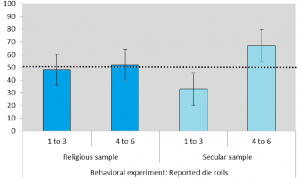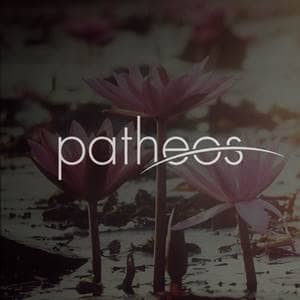What would you do if fate had been a little unkind to you, but you get the chance to make it up for yourself with a small lie?
Take, for example, the experimental setup that Shaul Shalvi and David Leiser, both at Ben Gurion University of the Negev used on two groups of Israeli students. One group was from a secular campus, the other from a ‘religious’ one – meaning that they were orthodox jews.
They asked them to roll a die by shaking it in a cup and then upending it. There was a small hole in the top of the cup, so the students – and no-one else – could see the results of the roll. They were told that they would get paid an amount proportional to the die roll. So if they rolled a 1, they would get 3 Shekels (about 75 US cents), but if they rolled a 6 they would get 18 shekels.
Then they rolled the die again – just to check that it wasn’t loaded. And once again, only they could see the results.
So, what happened? Did everyone faithfully report the number they got with the first die roll? Or did some people, dissatisfied with their luck the first time round, feel they deserved something better? Maybe they reported the second roll instead?
Well, this was a genuinely anonymous experiment, so Shalvi and Leiser couldn’t tell if any particular individual lied. But they could look at the statistics.
As you can see in the figure, the religious students reported rolling the same number of low (1-3) and high (4-6) numbers. In other words, what they reported was exactly what you would expect from chance.
The secular students, however, were much more likely to report rolling a 4-6. Some of them must be lying!
To understand why some secular students felt it was OK to lie, a week later Shalvi and Leiser asked some of the students to evaluate some examples of other people playing the die-rolling game.
These included examples in which the player was honest, examples in which the player was ‘justifiably’ dishonest (for example, they rolled a low number the first time, but honestly reported the higher number they got from the second roll), and ‘unjustifiably’ dishonest (in which the number to player reported was entirely fictional).
They found that religious students judged both kinds of lying more harshly than the secular students. But, more interestingly, while religious students were almost equally harsh in their judgement of justifiable and unjustifiable lies, or secular students there was a big difference between the two.
Secular students thought the the ‘justifiable’ lying really was justifiable! Religious students disagreed.
What this suggests is that secular student’s views of what is dishonest or not depends on the circumstances. If someone is feeling hard done by, it’s OK to tell a little lie to restore the balance. For religious students, lying is lying and that’s it.
Now, put this together with other research showing that religion and authoritarianism act together to stop people telling ‘white’ lies, and the previous post about research showing that religious people stick to the rules regardless of the consequences, and a picture begins to emerge.
Lying and trust go hand in hand. If everyone strictly follows the rules, then you know where you are. But if people are willing to bend the rules in their own interests, then communal life become much more tricky.
It seems to me that, while at first sight the rigid approach to moral rules seems harsh and possibly dangerous, it is probably essential for close communities. When you absolutely depend on your neighbours, you’d better be sure you know how they are going to behave!
So although it might seem crazy that religious people rely more on rules than on consequences when determining what is right and wrong, it might well be a sensible strategy when the circumstances are right.
![]()
Saul Shalvi, & David Leiser (2013). Moral Firmness Journal of Economic Behavior & Organization, 93, 400-4007 DOI: 10.1016/j.jebo.2013.03.014
 This article by Tom Rees was first published on Epiphenom. It is licensed under Creative Commons.
This article by Tom Rees was first published on Epiphenom. It is licensed under Creative Commons.














